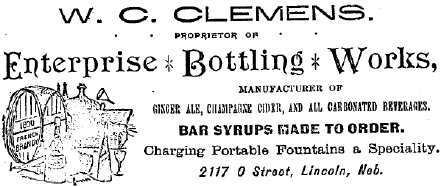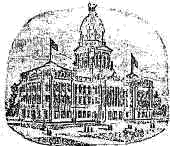LINCOLN
|
|
|
|
|
|
|
|
|
|
|
|
|
|
|
|
|
|
|
|
|
|
|
|
|
|
|
|
Page 260 stories in height, the walls being of brick with beautiful facing of oolitic limestone. The interior is tastefully finished in a style to correspond with the magnificence of the building. It cost $600,000. The University of Nebraska is a state institution of learning, occupying five substantial buildings which cost $250,000. It has among its facilities a fine laboratory, chemical apparatus, cabinet of minerals, library, etc., and an agricultural farm, consisting of 320 acres of rich land, a little more than a mile northeast of the city. The University is open to both sexes, tuition free. During the first three years the male students are taught military tactics. There is also a normal department for the training of teachers. The line of study in a preparatory course of two years, a short agricultural course of two years, a long course of agriculture, civil engineering, science, literature and the classics of four years. There are five different departments contemplated in the plan of the University, colleges of law, medicine and the fine arts, college of literature, science and arts, and an industrial college, consisting of agriculture, practical science, civil engineering, and the mechanical arts. The faculty, board of regents and other officers are composed of some of the best men in the state. The faculty and officers are as follows: |
||
|
Charles E. Bessey, Ph. D. |
acting Chancellor and professor of botany and horticulture. |
|
|
Henry E. Hitchcock, Ph. D. |
mathematics |
|
|
George McMillan, Ph. D. |
Greek |
|
|
August H. Edgren, Ph. D. |
modern languages and sanscrit |
|
|
Lewis E. Hicks, Ph. D. |
geology |
|
|
Grove E. Barber, M. A. |
Latin |
|
|
Lucius A. Sherman, Ph. D. |
English Literature |
|
|
George A. Howard, M. A. |
history |
|
|
Hudson H. Nicholson, M. A. |
chemistry and director of the chemical laboratory |
|
|
J. Sterling Kingsley, D. Sc. |
agriculture and biology |
|
|
DeWitt H. Brace, Ph. D. |
physics |
|
|
Thomas W. Griffith, 1st Lieutenant, U. S. Infantry |
military science and tactics |
|
|
Charles N. Little, Ph. D. |
civil engineering |
|
|
Rachel Lloyd, Ph. D. |
analytical chemistry |
|
|
Howard W. Caldwell, B. Ph. |
associate professor of history |
|
|
Ebenezer W. Hunt, B. A. |
associate professor of rhetoric and oratory |
|
|
Amos G. Warner, Ph. D. |
associate professor of economic and political science |
|
|
James T. Lees, Ph. D. |
principal Latin school and associate professor classical philology |
|
|
Harold N. Allen, B. Sc. |
adjunct professor, physics |
|
|
Hon. Robert W. Furnas |
lecturer on forestry |
|
|
Harry K. Wolfe, Ph. D. |
associate professor philosophy |
|
|
Sarah W. Moore |
painting and drawing, and lecturer on history of art |
|
|
T. Morey Hodgman, B. A. |
mathematics |
|
|
Vernon J. Emory, B. A. |
Latin |
|
|
Langdon Frothingham, D. V. M. |
agriculture and biology |
|
|
H. Elton Fulmer, M. A. |
chemistry |
|
|
Laurence Fossier, M. A. |
modern languages |
|
|
Ermina D. Cochran, M. A. |
piano, organ and voice culture |
|
|
Albert F. Woods, B. Sc. |
assistant botanical laboratory |
|
|
J. Stuart Dales, M. Ph. |
steward |
|
|
Ellen Smith, M. A. |
registrar and custodian of library |
|
|
Max Westerman |
clerk |
|
|
S. W. Perrin |
foreman, college farm |
|
|
The state asylum for the insane is a notable institution, located a short distance from the city. The building cost $275,000 and is a handsome and commodious structure, surrounded by pleasing and well kept grounds, 480 acres in extent. The number of patients under treatment is 316. The home of the Friendless, for homeless children, another of the benevolent institutions of the state, cost $28,000. The penitentiary, one of the finest penal intuitions in the country, costing $260,000 is located about a mile and a half south of the city. The number of inmates present is 369. The United States government building, located near the business center of the city, is am imposing and substantial stone structure which cost $200,000. It is occupied by the postoffice, custom house, U. S. Courts, Etc. The Lancaster County Court House is a most beautiful structure of Cleveland and Berean Sandstone, four stories high, with a tower fifty feet in height rising from the center. The interior is principally of copper and steel, thus making the building thoroughly fire-proof. It cost $200,000. The Nebraska Wesleyan University occupies a large and handsome building four stories high, 71 by 168 feet, which cost $70,000. The Cotner University, under the auspices of the Christian church, is located at Bethany Heights, four miles north of the city. The building is of Milwaukee pressed brick and trimmed with red sandstone, five stories high with towers on each side and at the front. The design is very beautiful. The courses of study are classical, liter- Page 261 ary, Biblical and scientific. The Seventh Day Baptists are erecting a large and costly college building. The Episcopal College for boys is to be erected at a cost of $50,000. The public school system of Lincoln ranks well with that of any of our western cities. There are eight handsome brick school buildings. The aggregate value of the property, including the grounds, amounts to $500,000; cost of maintenance, $100,000; number of teachers employed, 100; pupils enrolled, 10,000. There are many fine church buildings also in the city. The 42 church organizations have property aggregating in value $900,000, with a seating capacity of 14,000, and a membership of 10,000. The business buildings are many of them quite notable for their size, value and architecture. The Burr Block, seven stories high, cost $200,000; Richards Block, $50,000; Potvin Block, $40,000; Masonic Temple, $40,000; Odd Fellows Block, $30,000; the Exposition building, lately erected has a frontage of 150 feet on N street by 142 feet on 12th street. Its three floors each have over 10,000 feet of space, total space of flooring, 32,000 square feet. The building is largely composed of French plate glass, and cost $62,000. The Young Mens Christian Association are constructing a fine hall which is to cost $60,000. The excellence of the Lincoln banks is a good index to the solidity of the city financially. They are as follows: The American Exchange Bank, capital $100,000; Capital National, capital paid up, $300,000; First National, capital paid up, $200,000; German National, capital paid up, $100,000; Lancaster County, capital $50,000; Lincoln National, capital, $100,000; Lincoln Savings Bank and Safe Deposit Co., capital $250,000; Nebraska Savings, capital, $300,000; National, capital, $200,00; Union Savings, capital $200,000. The excellent railway connections give Lincoln exceptional opportunities for a wholesale trade with a large section of country, consequently quite a number of firms are doing an extensive jobbing business. The manufacturing and industrial interests of the city are also of considerable importance. There are here brick and tile works, canning factory, vinegar works, tannery, shoe factory, flour mills, machine shops, foundries, glue factory, pottery works, planing mills, cigar factories, paper mill, trunk factory, flaxseed mill, carriage and wagon shops, cornice works, broom factory, artificial stone works and many other industries. The Burlington and Missouri R. R. Co., is about to erect work shops in the suburbs, four miles north of the city, which will give employment to about 1,000 men. The Nebraska Stock Yards Co., whose capital is $1,000,000 have extensive stock yards which cost $300,000, in the western part of the city, Lincoln is well lighted with gas and electricity. The Lincoln Gas Co. operate their extensive plant with a capital of $325,000. The lines of street railway are well equipped and operated by five different companies which have 35 miles of track. The city water works are built on the stand-pipe system; 25 miles of water mains have been laid. The telephone system is extensive, 700 telephones being in use. There are 22 miles of paved streets and 37 miles of sewerage. The annual recurrence of the State Fair is an attractive feature to multitudes from all parts of the State. The associations grounds are about a mile north of the city. A number of large hotels are first class in all their appointments, and, with numerous comfortable but less pretentious establishments, afford excellent accommodations to the many strangers who are visiting the capital of the state. The newspaper press is well represented. There are three dailies, The Nebraska State Journal, The Lincoln Daily Call, and the Lincoln Daily News, five weeklies and seventeen other periodical publications. There are also four libraries, containing over 50,000 volumes, giving opportunity for study and literary culture. The population is 55,500. |
||
|
|
||
|
Robt. B. Graham |
Mayor |
|
|
Elmer B. Stephenson |
treasurer |
|
|
D. C. Van Duyn |
clerk |
|
|
E. P. Holmes |
attorney |
|
|
W. J. Houston |
police judge |
|
|
S. N. Melick |
marshal |
|
|
R. N. Townley |
engineer |
|
|
W. H. Newbury |
chief fire department |
|
|
I. N. Lyman |
water commissioner |
|
|
L. J. Byer |
street commissioner |
|
|
W. C. Rohde |
inspector for meat and livestock |
|
|
A. M. Bartram |
health officer |
|
|
E. J. Flaherty |
gas inspector |
|
|
V. H. Dyer |
sealer weights and measures |
|
|
Councilmen |
||
|
First Ward |
P. Hayden, Alexis Halter |
|
|
Second Ward |
J. C. Salsbury, Henry Veith |
|
|
Third Ward |
William McLaughlin, Joseph Burns |
|
|
Fourth Ward |
F. A. Boehmer, J. B. Archibald |
|
|
Fifth Ward |
H. M. Bushnell, S. S. Royce |
|
|
L. C. Pace, |
president of council |
|
|
Sixth Ward |
H. M. Rice |
|
|
Seventh Ward |
G. A. Bush, H. W. Orr |
|
|
Cemetery Trustees |
||
|
L. J. Byer |
President |
|
|
A. M. Davis |
treasurer |
|
|
A. G. Hastings |
secretary |
|
|
Board of Public Works |
||
|
W. J. Marshall |
Chairman |
|
|
Bd. of Education |
R. C. Manley, S. McConiga |
|
|
J. A. Wallingford |
president |
|
|
W. W. W. Jones |
A. G. Greenlee |
|
|
C. A. Wickersham |
S. D. Cox |
|
|
W. J. Marshall |
J. A. Edson |
|
|
O. E. Goodell |
S. J. Kent |
|
|
Betts & Weaver, coal, 1045 O |
Boyker, Wm. R., butcher, 27th and R |
© 2000, 2001 for NEGenWeb Project by Kathie Harrison
![]()
BUSINESS (LINCOLN) DIRECTORY. 265

![]()
![]()
![]()
266 NEBRASKA STATE (LINCOLN) GAZETTEER AND
![]()
![]()


